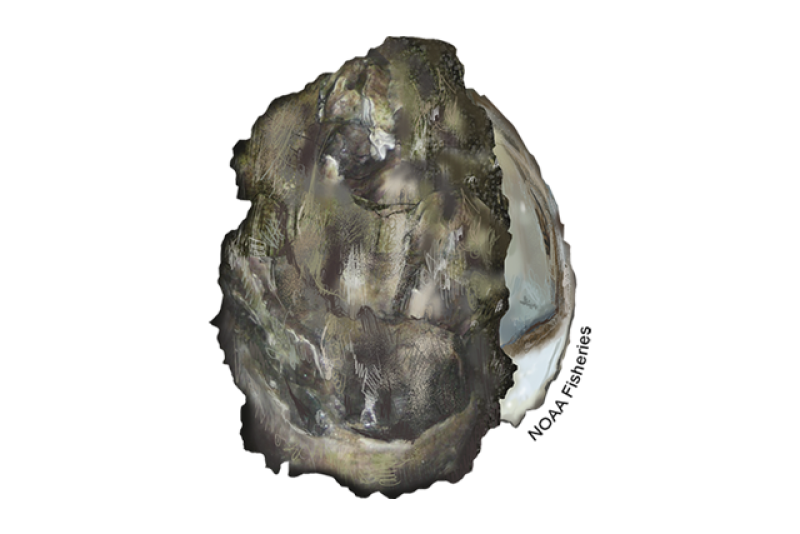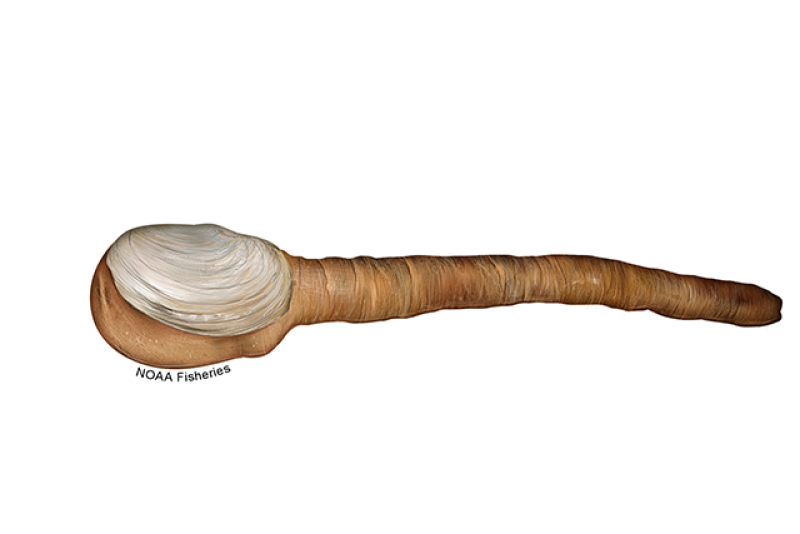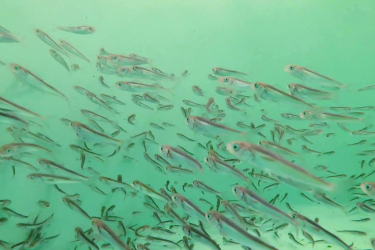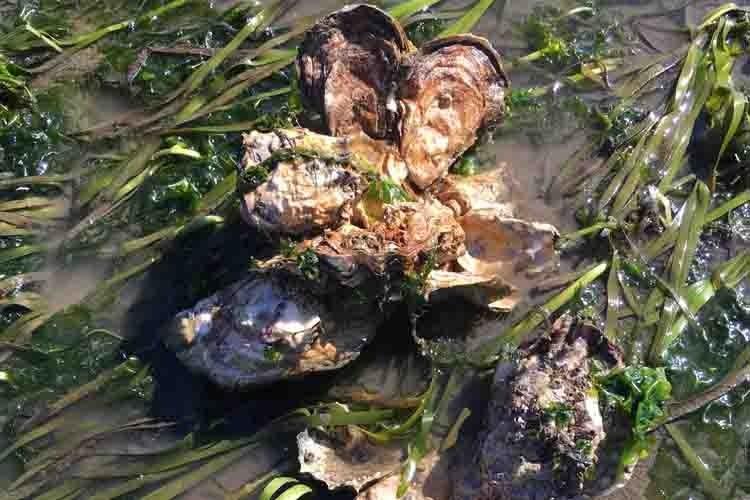 A cluster of bottom-cultured oysters grows in eelgrass in Willapa Bay, Washington. Credit: NOAA
A cluster of bottom-cultured oysters grows in eelgrass in Willapa Bay, Washington. Credit: NOAA
A cluster of bottom-cultured oysters grows in eelgrass in Willapa Bay, Washington. Credit: NOAA
About the Species
 A cluster of bottom-cultured oysters grows in eelgrass in Willapa Bay, Washington. Credit: NOAA
A cluster of bottom-cultured oysters grows in eelgrass in Willapa Bay, Washington. Credit: NOAA
A cluster of bottom-cultured oysters grows in eelgrass in Willapa Bay, Washington. Credit: NOAA
The Pacific oyster, introduced from Japan, is a popular seafood and West Coast aquaculture species. Oysters provide many benefits to the ecosystems in which they live in. They are filter feeders, cleaning the water as they eat—an adult oyster can filter up to 50 gallons of water per day. Oysters also form reefs which provide habitat for many species including fish and other invertebrates.
Appearance
- Pacific oysters can reach up to 10 inches in length.
- The shell is elongated, thick, rough and sometimes sharp. The inside of the shell is white to off/white with purple streaks.
- The shell has a “cupped” shape to it, giving rise to its alternate name “Pacific cupped oyster.”
Biology
- Oysters are part of the shellfish family. Like mussels, clams and scallops they are bivalve mollusks, and have a hinged shell.
- Adults are sessile—they stay in one place—and inhabit both intertidal and subtidal areas.
- Oysters have fast growth rates and high reproduction rates.
- Pacific oysters first mature as males, then later develop female reproductive capabilities.
- Each female can produce between 50 and 200 million eggs during a spawning event.
Scientific Classification
| Kingdom | Animalia | Phylum | Mollusca | Class | Bivalvia | Order | Ostreida | Family | Ostreidae | Genus | Magallana | Species | gigas |
|---|
Last updated by NOAA Fisheries on 03/20/2025
Featured News
 Chef Tyler Hadfield’s Curried Skate Wings with Tomato-Masala Chutney
Chef Tyler Hadfield’s Curried Skate Wings with Tomato-Masala Chutney
Ring In the New Year With These Crowd-Favorite Seafood Recipes
 Oyster growers harvest farmed shellfish from the Damariscotta River in Maine. NOAA has awarded several grants to small businesses working to develop new tools to advance sustainable U.S. aquaculture. (Image credit: C. Katalinas/ Maine Sea Grant)
Oyster growers harvest farmed shellfish from the Damariscotta River in Maine. NOAA has awarded several grants to small businesses working to develop new tools to advance sustainable U.S. aquaculture. (Image credit: C. Katalinas/ Maine Sea Grant)
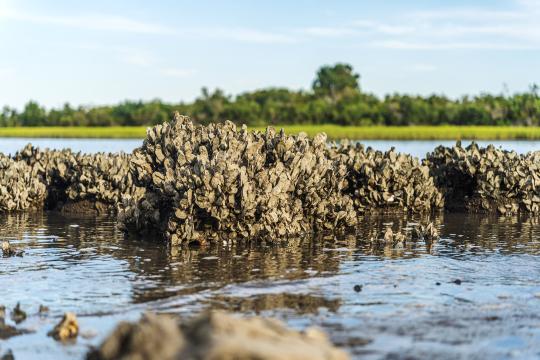 An oyster reef with lush greenery in the background. Credit: Adobe Stock
An oyster reef with lush greenery in the background. Credit: Adobe Stock
 Erik O'Brien and daughters at Kodiak Ocean Bounty farm in Larsen Bay, Alaska (Courtesy of Kodiak Ocean Bounty.)
Erik O'Brien and daughters at Kodiak Ocean Bounty farm in Larsen Bay, Alaska (Courtesy of Kodiak Ocean Bounty.)
Seafood Facts

Are Pacific Oysters Sustainable?
U.S. farmed Pacific oysters are a smart seafood choice because they are sustainably grown and harvested under U.S. state and federal regulations.
Availability
Available year-round.
Source
Estuaries, mostly in the Pacific Northwest.
Taste
Ranges from sweet to briny.
Health Benefits
Oysters are low in saturated fat and excellent sources of omega-3 fatty acids and iron.
Nutrition Facts
Servings: 1; Serving Weight: n/a; Calories: 81; Protein: 9.45 g; Total Fat: 2.3 g; Total Saturated Fatty Acids: 0.5 g; Carbohydrate: 0 g; Total Sugars: 0 g; Total Dietary Fiber: 0 g; Cholesterol: 50 mg; Sodium: 106 mgOyster Recipes
Looking for some ways to add oysters into your rotation? If you need some cooking inspiration, browse these recipes for bourbon grilled oysters, bacon-wrapped oysters, and more!
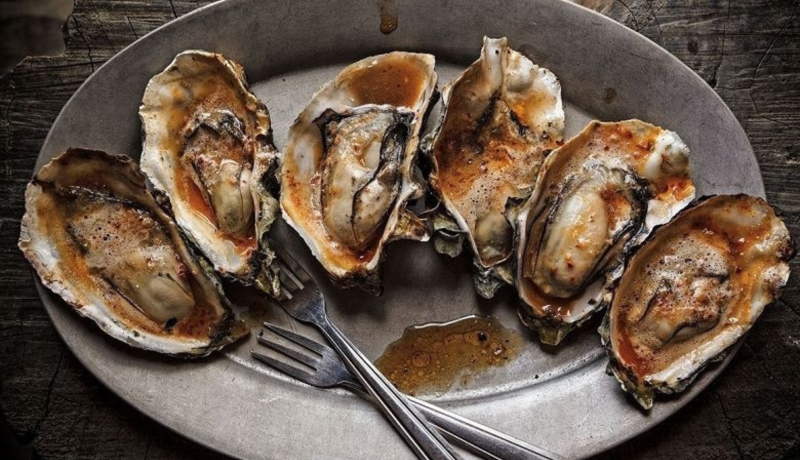
Last updated by NOAA Fisheries on 03/20/2025
Seafood News
 Celebrate Culinary Arts Month with a sustainable seafood recipe for every month of the year.
Celebrate Culinary Arts Month with a sustainable seafood recipe for every month of the year.
What Your Birth Month Says About Your Next Seafood Recipe
 Fresh-caught taʻape on ice. Credit: Conservation International Hawaiʻi.
Fresh-caught taʻape on ice. Credit: Conservation International Hawaiʻi.
Reducing Waste and Feeding Communities in Hawaiʻi with a Whole Fish Approach
 Chef Tyler Hadfield’s Curried Skate Wings with Tomato-Masala Chutney
Chef Tyler Hadfield’s Curried Skate Wings with Tomato-Masala Chutney
Ring In the New Year With These Crowd-Favorite Seafood Recipes
 NOAA Fisheries, in collaboration with Blue Ocean Mariculture, is conducting a multi-year pilot study to evaluate observational methods and tools for studying Hawaiian monk seal behavior. Courtesy of Blue Ocean Mariculture
NOAA Fisheries, in collaboration with Blue Ocean Mariculture, is conducting a multi-year pilot study to evaluate observational methods and tools for studying Hawaiian monk seal behavior. Courtesy of Blue Ocean Mariculture
AI Meets Aquaculture to Study Hawaiian Monk Seal Interactions With Net Pens
Last updated by NOAA Fisheries on 03/20/2025
Last updated by NOAA Fisheries on 03/20/2025
Aquaculture
U.S. farmed Pacific oysters are a smart seafood choice because they are sustainably grown and harvested under U.S. state and federal regulations.

Environmental Impact
Oysters provide net environmental benefits by removing excess nutrients and improving water quality.

Feeds
Growing oysters requires no feed—they filter phytoplankton directly from the water column.

Farming Methods
Oysters are grown in tidal areas. They can be grown directly on the beach bottom or in mesh bags, trays or cages that are either anchored in the water column or floated on rafts.

Human Health
Shellfish toxins and bacteria occur naturally in the environment and can cause foodborne illnesses. State and federal regulations require monitoring of farmed oysters to ensure they are safe to eat.
Management
- Permitting for shellfish aquaculture is governed by federal, state and local governments.
- The federal agencies involved are NOAA, the Army Corps of Engineers, U.S. Fish & Wildlife Service, U.S. Department of Agriculture, the Environmental Protection Agency, the Food and Drug Administration, the Bureau of Ocean Energy Management, and the Coast Guard.
- Information on shellfish aquaculture permitting can be found in the Shellfish Growers Guide (PDF, 10 pages).
- A variety of shellfish aquaculture tools, including maps and models, are available to coastal managers.
- All fisheries and aquaculture farms in federal waters must adhere to federal regulations including those in the Magnuson-Stevens Fishery Conservation & Management Act, the Endangered Species Act, the National Environmental Policy Act, the Clean Water Act, and the Marine Mammal Protection Act.
Farming Methods
- Juvenile oyster (seed) production:
- Oyster larvae are bred in hatcheries and fed a diet of algae for 2 to 3 weeks.
- Larvae then attach to a provided substrate, usually old oyster shells.
- Settled larvae are transported to grow-out sites in coastal waters.
- Mature oyster grow-out:
- On-bottom – directly on the beach bottom in tidal areas.
- Off-bottom – in racks, mesh bags or cages that are submerged and attached to anchored frames in the intertidal zone.
- Suspended culture – bags or cages are attached to rafts and floated in the tidal zone.
Production
In 2019, the United States produced 42.3 million pounds of oysters (both Eastern and Pacific oysters), valued at $221 million.
Environmental Considerations
- Habitat:
- Oyster farming has a benign ecological footprint, with little disturbance of sediments or aquatic vegetation during grow-out.
- Some oyster harvesting methods involve dredging, but long-term effects on the environment are rare.
- Feeds:
- Once past the larval stage, oysters do not need to be fed because they filter their food from the water column.
- Genetics:
- The Pacific oyster is native to Japan, so there is some concern about the species outcompeting native oysters. However, this has not been an issue in the United States.
Ecosystem Services
- Water quality improvements:
- Oysters are filter-feeders, removing algae, organic matter and excess nutrients from the water column as they grow and improving water quality.
- When oysters are harvested, excess nutrients, such as nitrogen and phosphorus, are removed from the ecosystem.
- Providing habitat:
- Oysters and the gear used to farm oysters provide habitat for marine organisms.
- Oyster beds stabilize coastal sediments and help minimize impacts from storm surges.
Human Health
- Shellfish toxins:
- Shellfish poisoning is an illness that can occur from eating contaminated shellfish.
- Shellfish can assimilate the toxins that cause shellfish poisoning from the algae on which they feed.
- Early warning systems exist to detect harmful algal blooms that produce toxins.
- New technologies, such as the Environmental Sample Processor, provide near real-time detection of harmful algal species.
- For more information on the prevention and monitoring of harmful algal blooms, read about NOAA's Harmful Algal Bloom forecasting program.
- Pathogenic bacteria:
- The bacteria Vibrio parahaemolyticus (Vp) and Vibrio vulnificus (Vv) occur naturally in the environment and can cause foodborne illness from consuming raw shellfish.
- Ingestion of undercooked or raw shellfish with Vp or Vv can lead to gastrointestinal illness.
- Public health officials monitor shellfish from growing areas to ensure they are safe to eat.
Last updated by NOAA Fisheries on 03/20/2025
Science Overview
- Growth and reproduction:
- The Northwest Fisheries Science Center’s Kenneth K. Chew Center for Shellfish Research & Restoration includes a modern shellfish hatchery for research and production of native Pacific oysters.
- The Northeast Fisheries Science Center’s Milford Lab is finding ways to breed larger oysters and increase survival of larvae.
- Ocean acidification:
- Acidification causes a number of changes in water chemistry that may be stressful to estuarine organisms.
- Ocean acidification and its impacts on shellfish are being investigated by NOAA and other labs. For more information, visit NOAA’s Ocean Acidification Program.
- Ecosystem services:
- The Northwest Fisheries Science Center, in collaboration with The Nature Conservancy, Washington Sea Grant, the Jamestown S'Klallam Tribe, and seven shellfish growers, is using GoPro cameras placed around shellfish aquaculture beds to document the diversity of species that use this nearshore habitat.
Last updated by NOAA Fisheries on 03/20/2025
Documents
NOAA Fisheries Alaska Fiscal Year 2022 Aquaculture Accomplishments
The Alaska Regional Office and Alaska Fisheries Science Center continue coordinated efforts to…
NOAA Fisheries Alaska Fiscal Year 2021 Aquaculture Accomplishments
This report highlights the recent work being done by the Alaska Regional Office and Alaska…
Alaska Mariculture Workshop Summary Report
Summary of a multi-day aquaculture workshop with more than 60 mariculture development stakeholders…
Research
Current Research at Milford Laboratory
We develop probiotics for use in oyster hatcheries and perform studies in aquaculture gear as habitat for marine life, nutrient bioextraction studies, shellfish genetics research, offshore shellfish aquaculture potential, and shellfish responses to ocean…
Effects of Harmful Algal Blooms on West Coast Fishing Communities
Learn more about how harmful algal blooms change ecosystems and coastal communities.
Aquaculture and Marine Fish and Shellfish Research in the Pacific Northwest
Science to support sustainable wild-caught and hatchery-raised fisheries.
Finfish and Shellfish Aquaculture Research in the Pacific Northwest
We develop and optimize technologies for the artificial production of marine fish and shellfish.
Last updated by NOAA Fisheries on 03/20/2025
